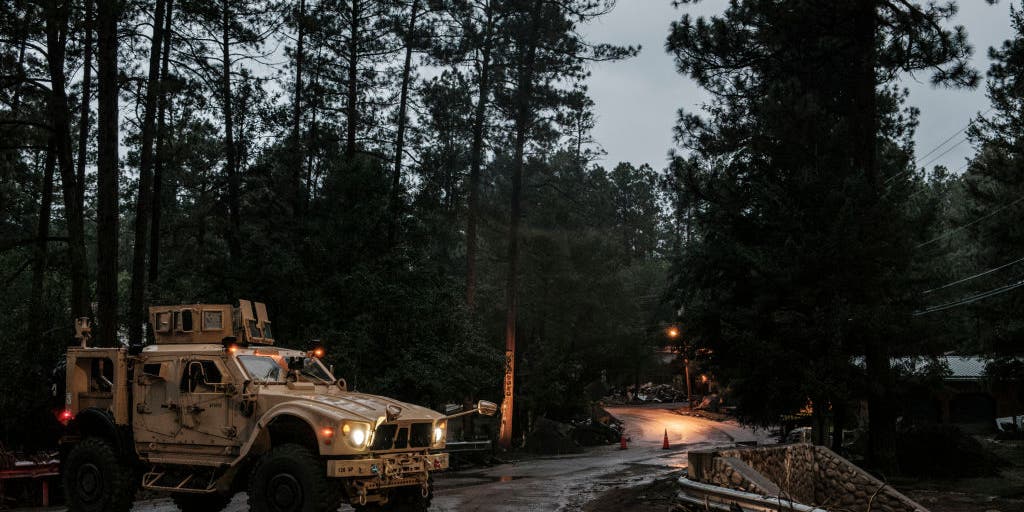Flash Flood Emergencies: A Guide To Survival And Prevention

Table of Contents
Understanding Flash Flood Risks
Flash floods are characterized by their sudden onset and rapid rise in water levels, often with little to no warning. Understanding the risks is the first step in effective preparedness.
Identifying High-Risk Areas
Certain geographical locations are inherently more vulnerable to flash floods. Identifying these high-risk areas is paramount to effective flash flood prevention.
- Proximity to Rivers and Streams: Areas located near rivers, streams, and other bodies of water are especially vulnerable to rapid flooding, particularly during periods of heavy rainfall.
- Mountainous Terrain: Steep slopes and canyons can channel large volumes of water quickly, leading to flash floods in downstream areas.
- Urban Drainage Systems: Inadequate or overwhelmed drainage systems in urban areas can contribute to rapid water accumulation and flash flooding.
- Low-Lying Areas: Areas situated in valleys or low-lying plains are more susceptible to water accumulation during intense rainfall events.
Using flood maps and online resources is crucial for assessing your risk. Websites like the National Weather Service (NWS) and FEMA provide valuable tools and information to determine your property's vulnerability. Apps like the FEMA app also provide real-time alerts and flood risk information.
Recognizing Flash Flood Warning Signs
Recognizing the warning signs of an impending flash flood is vital for timely evacuation and safety.
- Visual Cues: Rapidly rising water levels in streams and rivers, overflowing banks, and muddy water are clear indicators of an approaching flash flood.
- Auditory Cues: A rumbling sound coming from upstream, indicating a surge of water, can be a crucial warning sign.
- Weather Alerts: Pay close attention to flash flood warnings and severe weather alerts issued by your local weather service. These warnings provide critical information about the timing and severity of potential flooding.
Other warning signs include debris accumulating in streams, unusual animal behavior (animals moving to higher ground), and a rapid increase in the speed or volume of water flow. Heeding official warnings is critical—never underestimate the power of a flash flood.
Flash Flood Survival Strategies
Knowing what to do during a flash flood can be the difference between life and death. Prioritizing flash flood safety is essential.
Immediate Actions During a Flash Flood
If a flash flood is imminent or already underway:
- Seek Higher Ground Immediately: This is your top priority. Move to higher elevations as quickly and safely as possible.
- Move to a Sturdy Building: If you cannot reach higher ground immediately, seek shelter in a sturdy building on higher floors.
- Avoid Contact with Floodwaters: Floodwaters are extremely dangerous; they can contain contaminants, debris, and strong currents that can sweep you away. Remember the motto: "Turn around, don't drown."
- Call for Help: Contact emergency services immediately if you are trapped or in danger.
Essential Emergency Preparedness
Proactive flash flood preparedness is essential. This includes:
- Family Emergency Plan: Develop a detailed plan outlining meeting points, communication strategies, and evacuation routes.
- Emergency Kit: Assemble a kit containing essential supplies, including water (at least one gallon per person per day), non-perishable food, a first-aid kit, a flashlight, a battery-powered radio, and important documents.
- Stay Informed: Regularly monitor weather reports and alerts through your local news, the NWS website, or weather apps. Consider investing in a weather radio.
Regularly reviewing and updating your emergency plan and kit is crucial to ensure their effectiveness.
Flash Flood Prevention and Mitigation
Effective flash flood prevention involves a combination of community-level initiatives and individual actions.
Community-Level Prevention
Local governments play a critical role in flood mitigation and building community resilience.
- Improved Drainage Systems: Investing in robust drainage infrastructure can significantly reduce the risk of flash floods.
- Flood Barriers: Construction of flood barriers in high-risk areas can help protect homes and businesses.
- Watershed Management: Implementing responsible land management practices in watersheds can help control water flow and reduce the risk of flooding.
- Early Warning Systems: Developing and maintaining effective early warning systems are crucial for timely alerts and evacuations.
Participate in community preparedness programs and initiatives to help strengthen your community's resilience against flash floods.
Individual Actions for Prevention
Individual actions also play a significant role in flood prevention and enhancing home safety.
- Avoid Construction in Floodplains: Building in flood-prone areas increases the risk of damage and potential loss of life.
- Maintain Proper Drainage Around Homes: Regularly clean gutters, downspouts, and drainage systems to prevent water accumulation.
- Plant Vegetation: Planting vegetation can help absorb rainwater and reduce runoff.
- Elevate Electrical Appliances: Keep electrical appliances and other valuable items elevated to reduce damage from floodwaters.
Consider purchasing homeowner's insurance and flood insurance to protect your property from potential damage.
Conclusion
Flash floods are a serious threat, but understanding the risks, implementing effective survival strategies, and taking proactive steps towards prevention can significantly reduce the impact of these devastating events. Remember the key takeaways: understanding your risk, having a robust emergency plan, and taking proactive steps for both individual and community-level flash flood prevention. Develop a comprehensive flash flood safety plan today for your home and family. Take action now to protect yourself and your loved ones. Learn more about flash flood prevention tips and flash flood emergency preparedness to ensure the safety of your community. Don't wait for a disaster—prepare for flash flood emergencies now!

Featured Posts
-
 Alcaraz And Sabalenka Triumph In Rome Italian Open Strong Start
May 26, 2025
Alcaraz And Sabalenka Triumph In Rome Italian Open Strong Start
May 26, 2025 -
 Le Frere D Albert Luthers Thierry Annonce Son Deces
May 26, 2025
Le Frere D Albert Luthers Thierry Annonce Son Deces
May 26, 2025 -
 Luksuzni Penzionerski Zivot Realnost Za Neke San Za Mnoge
May 26, 2025
Luksuzni Penzionerski Zivot Realnost Za Neke San Za Mnoge
May 26, 2025 -
 La Justice Face A Marine Le Pen Analyse D Un Jugement Crucial
May 26, 2025
La Justice Face A Marine Le Pen Analyse D Un Jugement Crucial
May 26, 2025 -
 Paris Roubaix 2025 A Gallery Of Gravel Tech Big Tyres And Innovative Solutions
May 26, 2025
Paris Roubaix 2025 A Gallery Of Gravel Tech Big Tyres And Innovative Solutions
May 26, 2025
